
Through our website, we want to bring people closer to delicious, creative meals that nourish both body and soul. We don’t intend to become famous chefs –we just love food!
We firmly believe in celebrating the beauty of different cultures through their cuisine. From home kitchens to 5-star restaurants, each meal has its own secret recipe for success.
The love for Saffron initially inspired us on this journey, but our mission is much larger than that. We strive to provide helpful resources and meaningful conversations about organic farming techniques, cooking tips and culinary customs from around the world.
If you’d like to join us in showcasing your special family recipes or other noteworthy ideas relating to food culture, please reach out at [email protected] –your contribution will be highly cherished!
Now love yourself and enjoy this one ...
Easy Dumpling Soup is one of my absolute favorite things to throw together if I want a quick-and-simple homemade lunch or an effortless dinner that’s still wholesome, comforting, and budget-friendly. I’ve designed this recipe to be as versatile as possible, dressing up mostly store-bought ingredients, in order to scratch that “itch” for whatever takeout favorite I’m craving when ordering out isn’t on the menu.
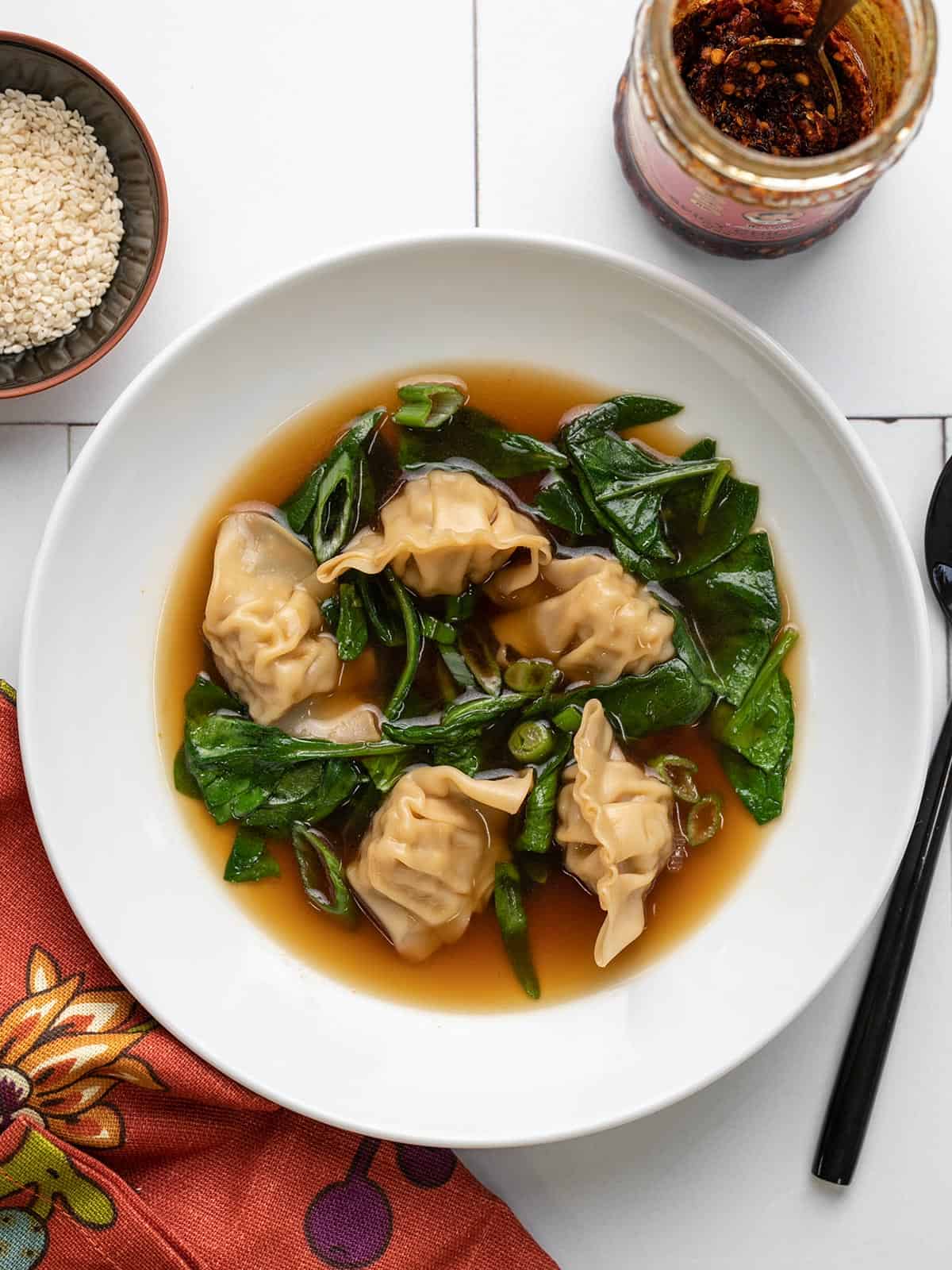
What is dumpling soup?
Our version of dumpling soup is a quick, semi-homemade soup inspired by dumpling soups found in Chinese, Korean and Japanese cuisines. The soup features a savory clear broth, delicate meat-filled dumplings, fresh greens, and an array of condiments to sprinkle on top. Here’s what you need for this Easy Dumpling Soup:
- Frozen dumplings — You can find Asian-style dumplings in the freezer section, usually filled with pork, vegetables, shrimp, or a combination of those ingredients.
- Broth — We fortified our vegetable broth with soy sauce and toasted sesame oil!
- A handful of fresh greens — like sliced green onions, fresh spinach, or baby bok choy
- Condiments — Use anything your heart desires! Try chili crisp, sesame seeds, black vinegar, cilantro, and more!
Is this an authentic recipe?
No, this is not an authentic dumpling soup, but we highly encourage you to read more about the wide variety and rich culture surrounding dumplings. Also, check out these recipes for authentic Chinese potstickers and Xiaolongbao (soup dumplings), Korean mandu, and Japanese gyoza.
What kind of dumplings to buy
Most grocery stores offer a variety of frozen dumplings options of different sizes, shapes, and fillings (usually pork, vegetable, shrimp, or a combination of those flavors)—and any type of frozen dumpling will work for this recipe. If you’re operating on an extra-tight budget, visiting an Asian grocery store is a great place to find a wider selection, larger quantities, and even lower prices.
How to know the dumplings are fully cooked:
Frozen dumplings are usually on the smaller side, so they cook quickly when added to boiling broth. However, since our suggested cook time is only based on the handful of brands we’ve tried (and there are so many others!), I highly recommend consulting the package directions on your dumplings to ensure you are cooking them long enough—as well as checking the suggested serving size to make sure you are preparing enough for two people.
Are the leftovers ANY good?
I would not recommend saving these leftovers. As it sits, the dumplings will keep soaking up the broth until they bloat and then fall apart. Instead, just make the amount you think you will eat, which is why I’ve developed the recipe for two servings rather than four. Since it comes together so quickly, it wouldn’t be the end of the world if you decided to make it twice in one night!
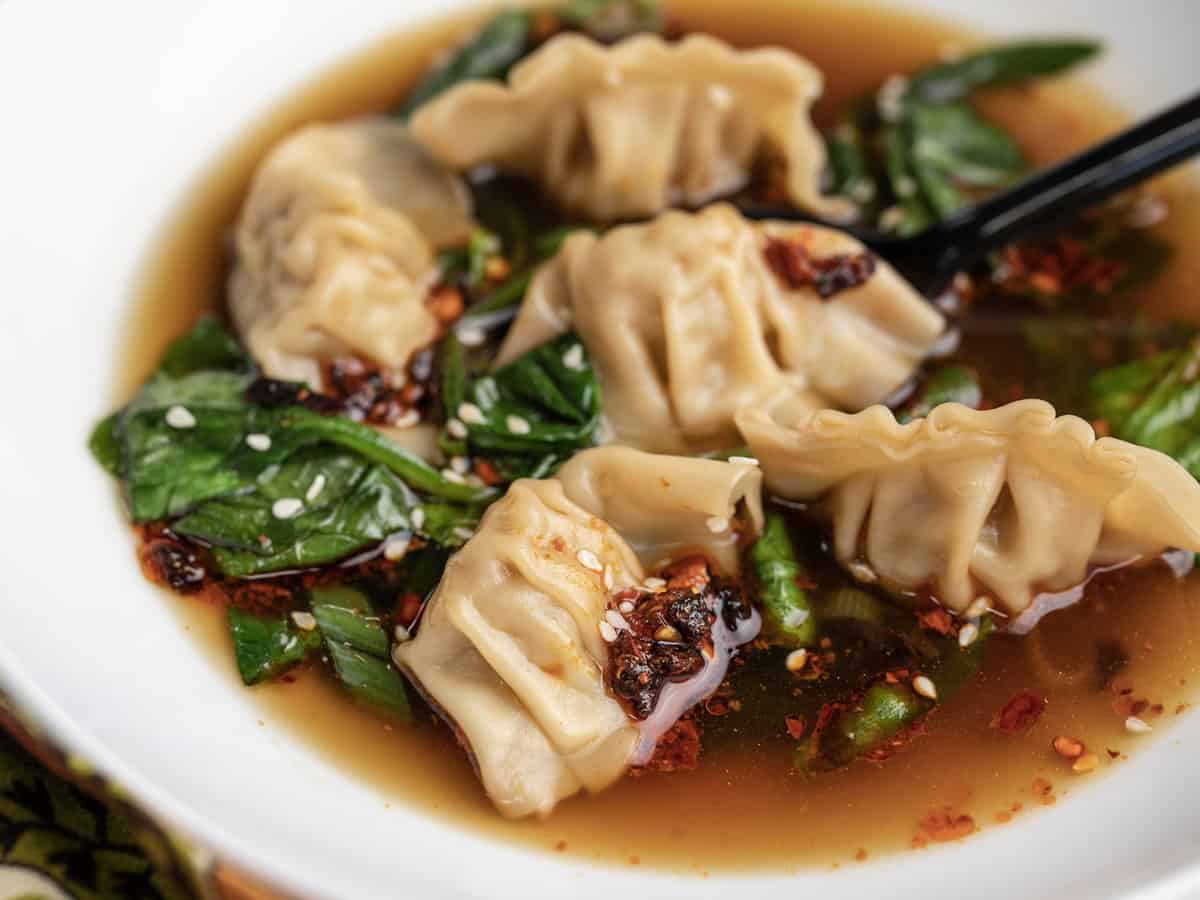
Take your Dumpling Soup to the next level
Some great flavor and topping additions for this soup are:
- Cubed tofu, cooked chicken, or another prepared protein
- Mushrooms, or other fresh or frozen vegetables
- Half of a hard-boiled egg
- Fish sauce
- Kimchi
- Cilantro
- Mirin
- Rice Vinegar or Lime Juice
- Miso paste
- A prepared sauce like Sichuan chili crisp, chili garlic sauce, sriracha, teriyaki sauce, or a prepared “dumpling sauce”
- Sesame seeds, crushed nori, or a store-bought Furikake blend
My go-to Topping combinations
Plan to add any extra condiments and toppings directly to each serving bowl, so each person can mix and match them to suit their tastes. My go-to topping combinations are (per bowl):
- 1 Tbsp kimchi + handful of torn cilantro
- ¼ tsp Szechuan chili oil + hardboiled egg
- Sliced mushrooms + nori + sesame seeds
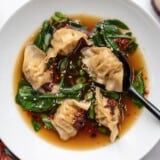
Easy Dumpling Soup
Ingredients
- 2 cups vegetable broth* $0.24
- 1 Tbsp soy sauce $0.06
- 1 tsp toasted sesame oil $0.06
- 1/4 tsp fish sauce, optional $0.02
- 1 green onion, thinly sliced, white and green parts separated $0.11
- 10 frozen dumplings** $2.00
- 1/2 cup fresh spinach*** $0.15
Garnishes, optional
- 1/2 tsp sesame seeds $0.03
- 1 Tbsp Sichuan Chili Crisp $0.31
Instructions
- Combine the vegetable broth, soy sauce, toasted sesame oil, and the white parts of a sliced green onion in a medium-sized pot. (If using, also add the fish sauce, pre-cooked proteins or tofu, and any fresh or frozen vegetables that need time to soften.)
- Bring the broth up to a boil on medium-high heat. Once boiling, add the dumplings.
- Cover the pot and allow the soup to come back up to a boil. Boil the dumplings for about 2 minutes or until they are cooked through. (Consult package directions.)
- Turn off the heat and stir in the green parts of the sliced green onion and a handful of spinach.
- Split the soup into 2 serving bowls and top with any desired condiments.
See how we calculate recipe costs here.
Notes
** You can use any flavor (pork, vegetable, chicken, etc.), but I prefer ones with pork and vegetables. *** or baby bok choy
Nutrition
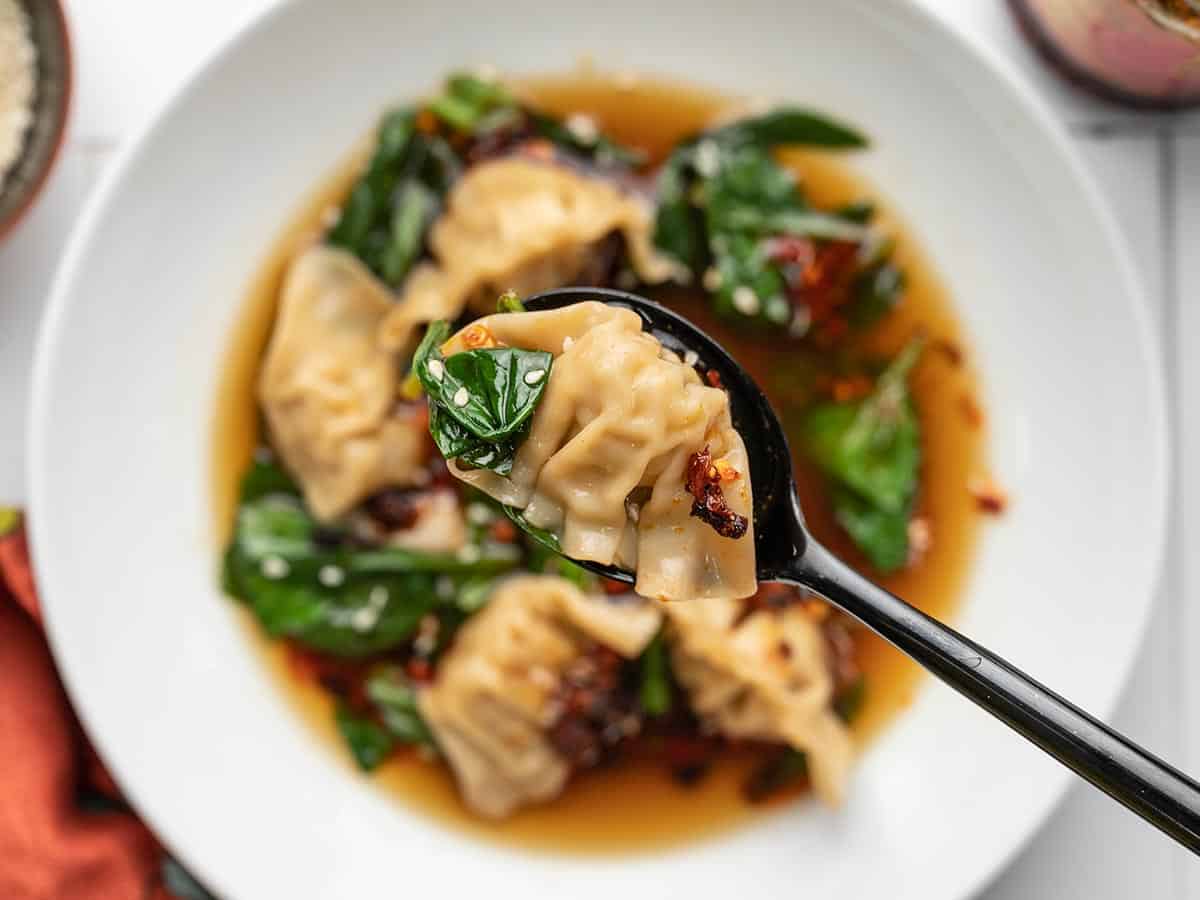
How to Make easy dumpling soup - Step by Step Photos
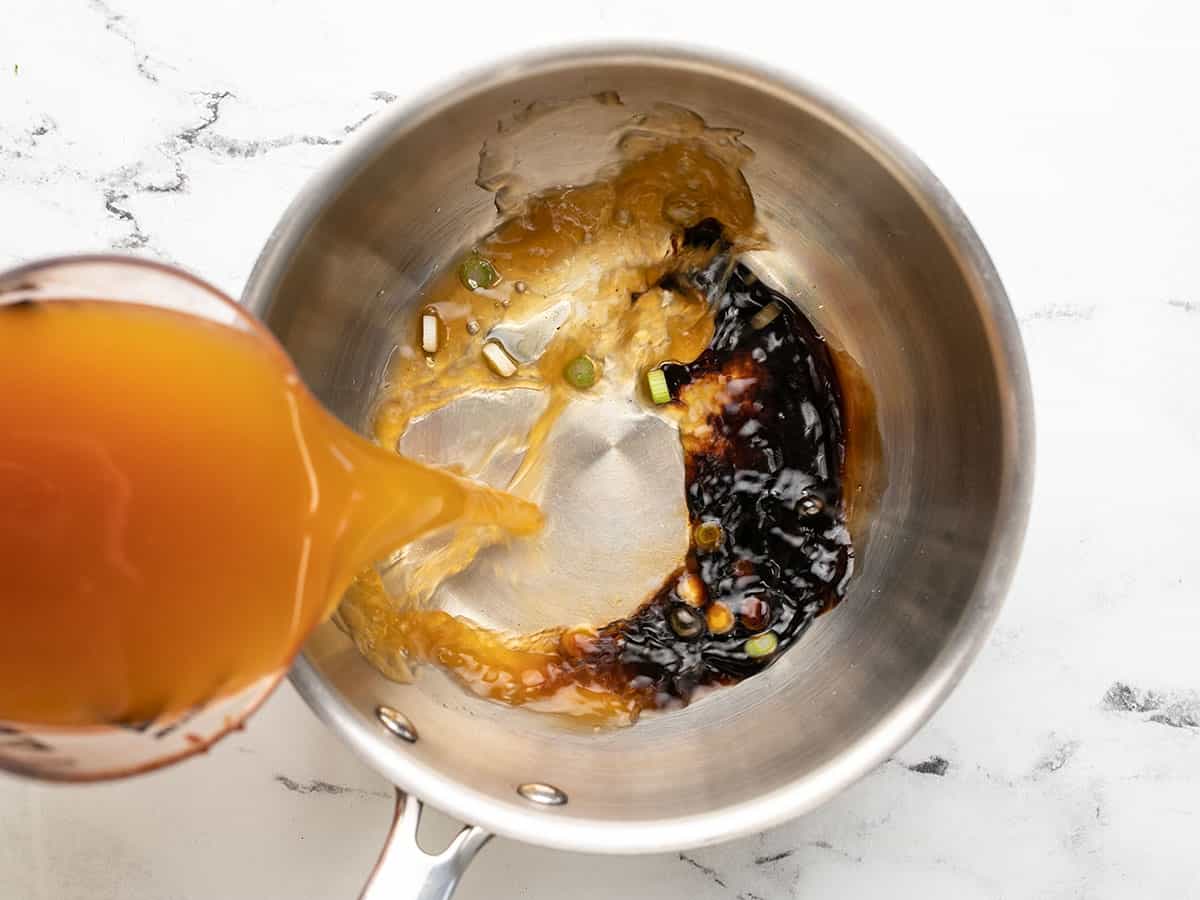
In a medium-sized pot, combine 2 cups of vegetable broth, 1 Tablespoon of soy sauce, 1 teaspoon of toasted sesame oil, and the white parts of a thinly sliced green onion (set the green parts aside for garnish), and cook over medium-high heat. You should also add the fish sauce now, if using — as well as any other extra ingredients that require some cooking time, like leftover cooked proteins from the fridge, tofu, mushrooms, or any other fresh or frozen vegetables that need time to soften.
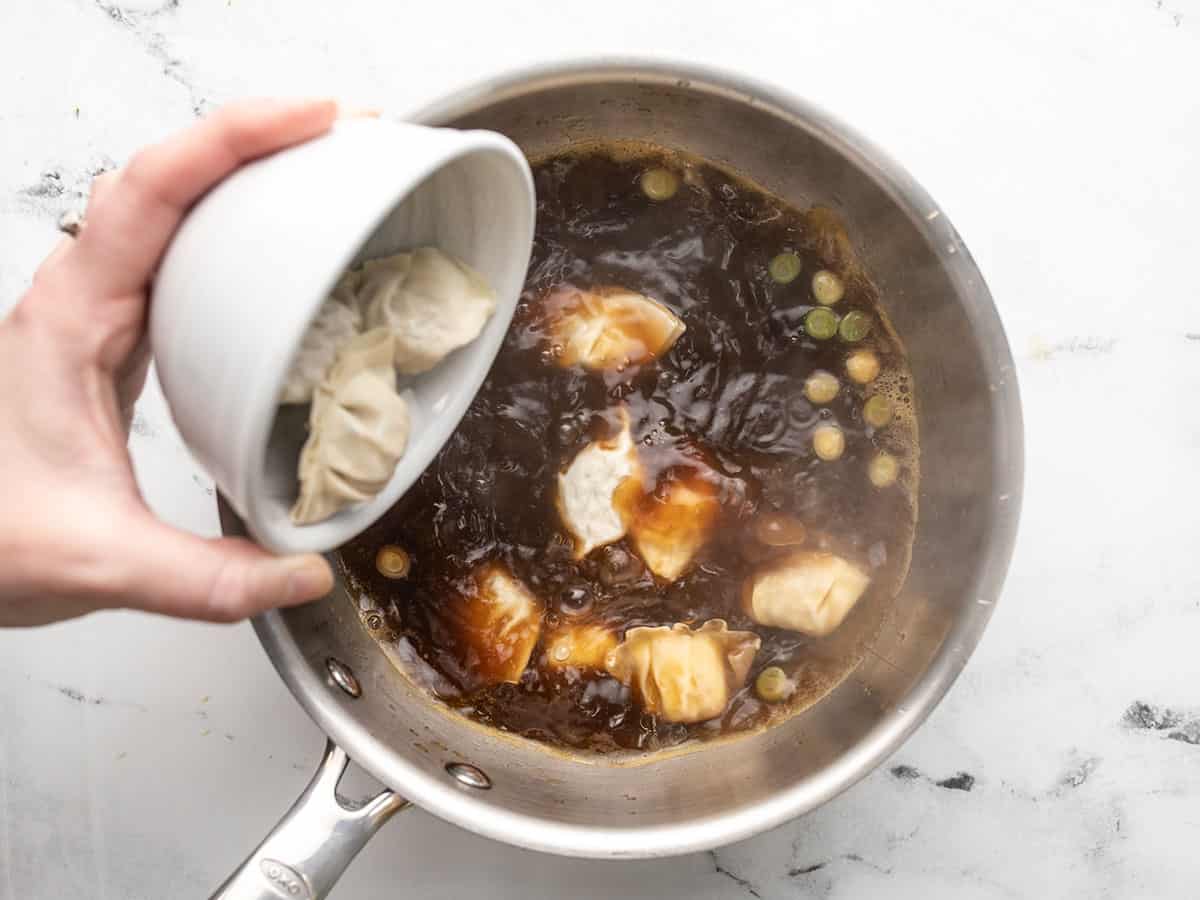
Bring the broth up to a boil on medium-high heat. Once boiling, add 10 frozen dumplings. Cover and allow the soup to come back up to a boil. Boil the dumplings for about 2 minutes or until they are cooked through. (Check out the suggested cooking time on your dumpling packaging to insure this will be enough time to cook them all the way through — at the same time, also check the nutrition label to make sure you add the correct amount for two servings.)
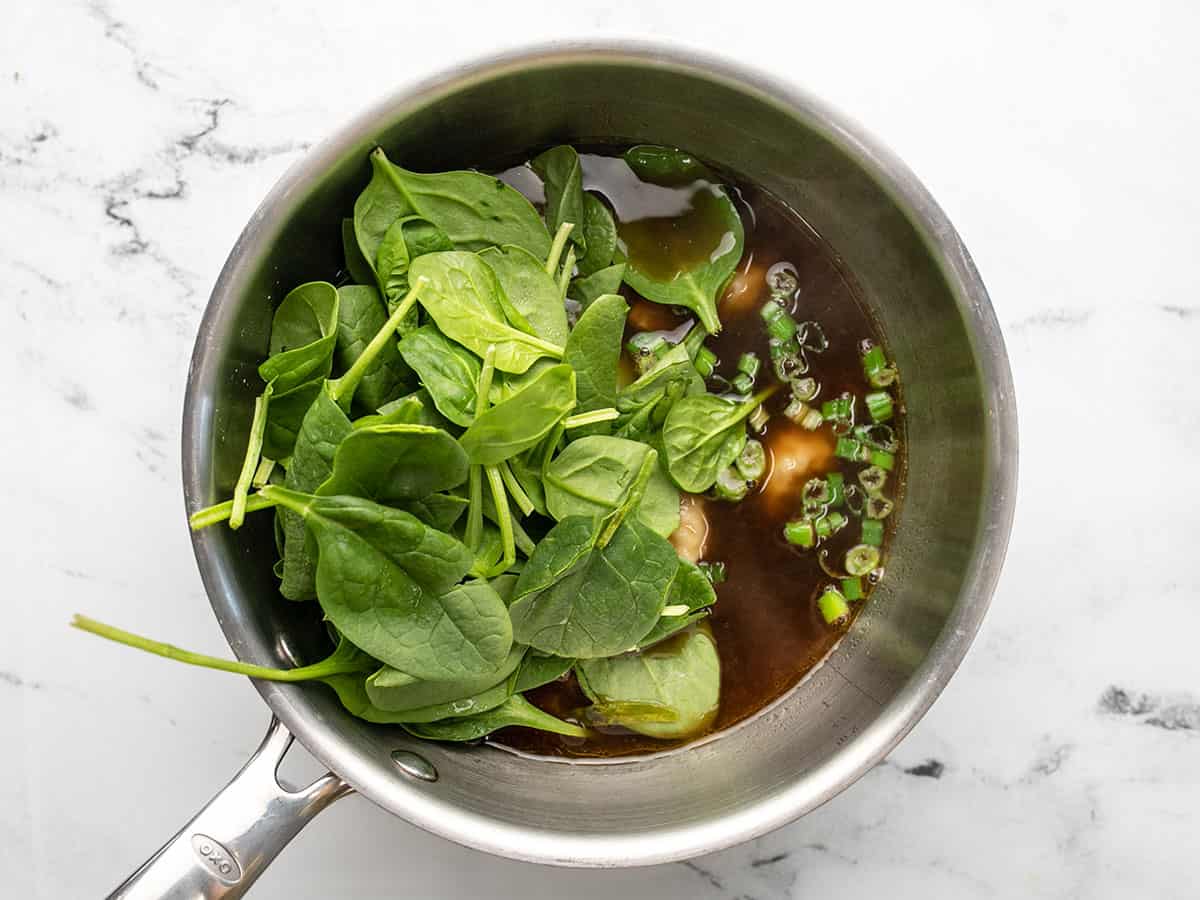
Turn off the heat and stir in 1/2 cup of fresh spinach and the reserved green onion slices.
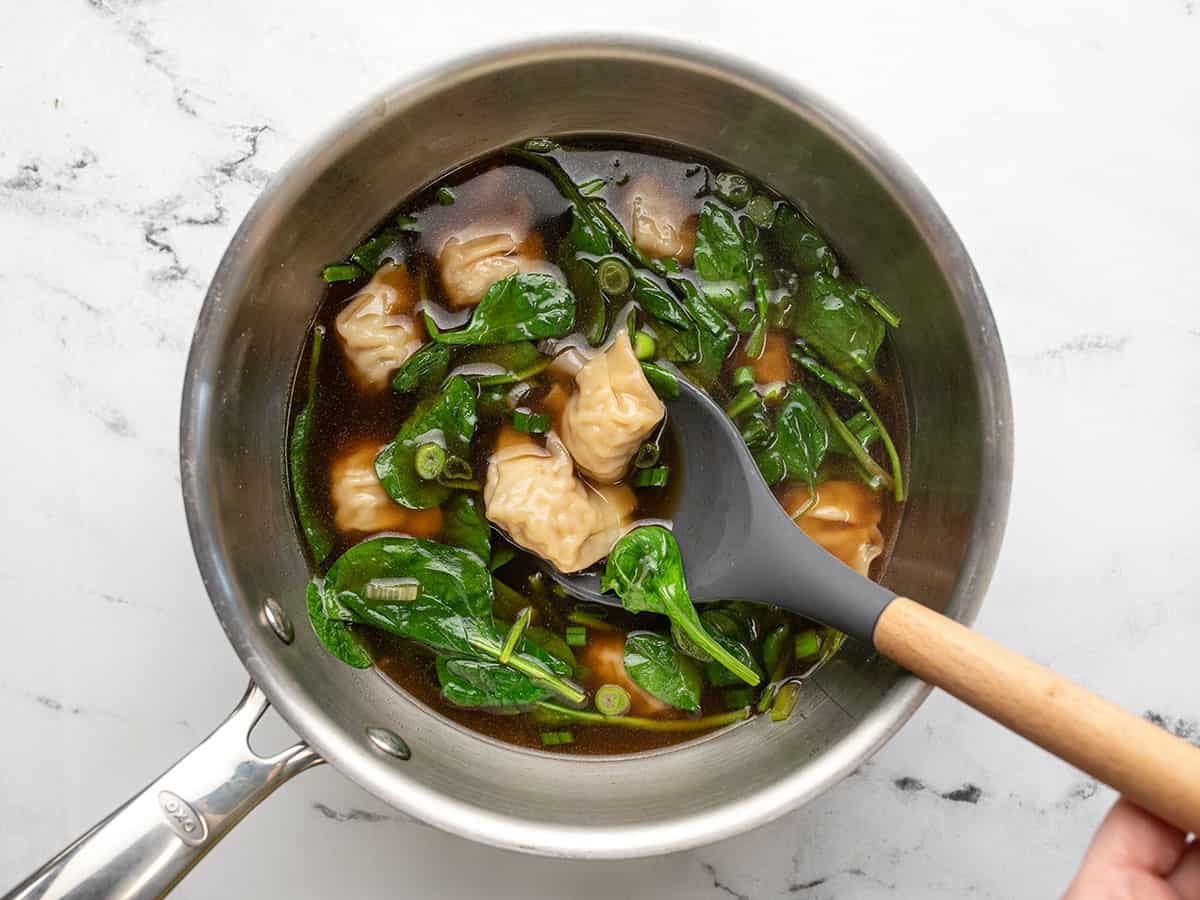
Split the soup into two serving bowls and top each bowl with your desired garnishes. We chose to sprinkle ours with a few sesame seeds and a heaping spoonful of Sichuan Chili Crisp!
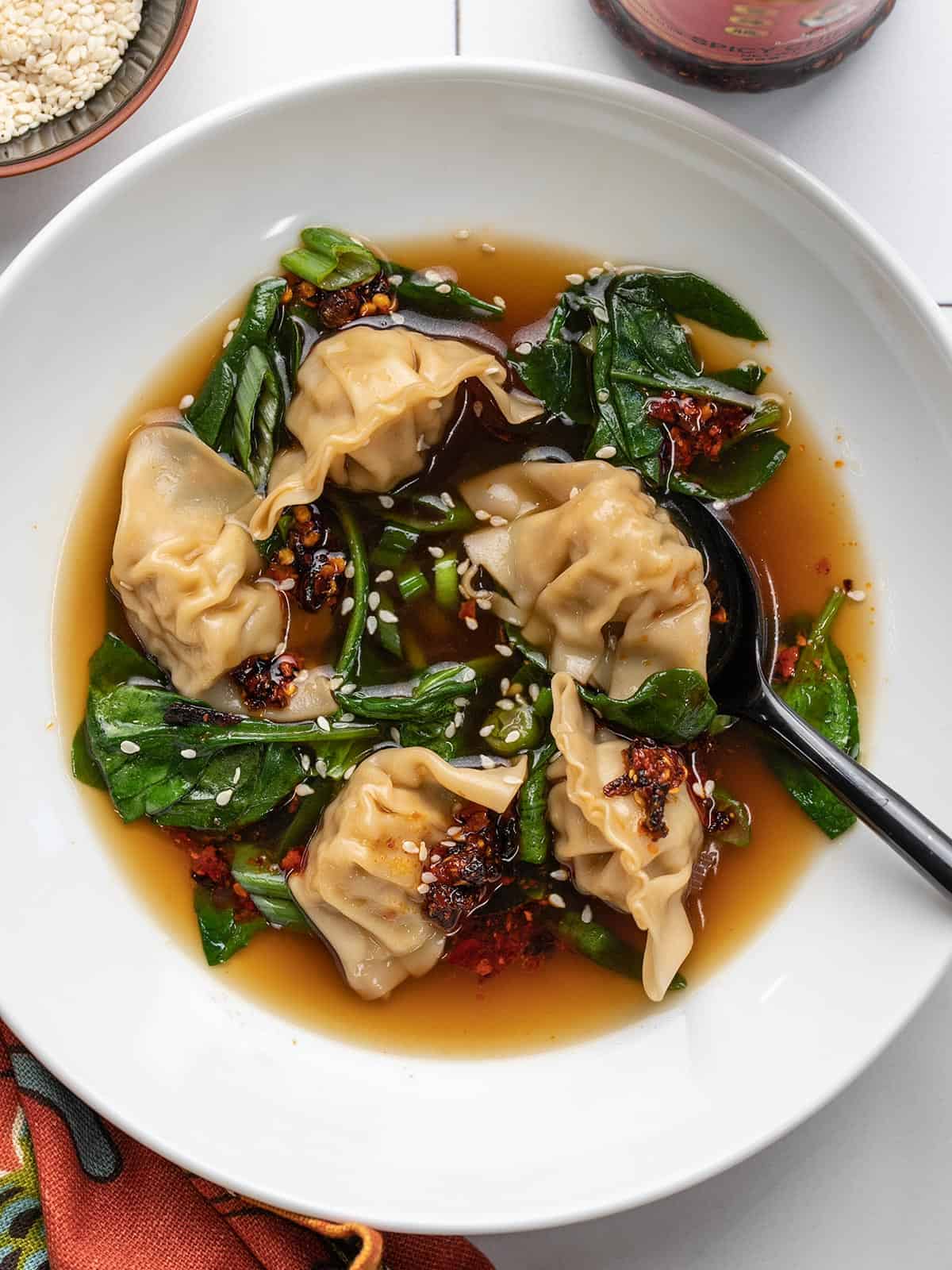
GET IN MY BELLY!
MORE “TAKE-OUT FAKE OUT” RECIPES

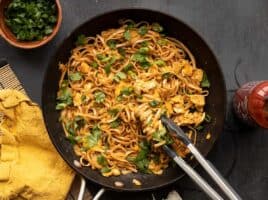
Spicy Sriracha Noodles
$2.50 recipe / $1.25 serving
Baked Chicken Wings
$10.35 recipe / $3.45 serving
Thin and Crispy Pizza Crust
$0.59 recipe / $0.30 per pizzaThe post Easy Dumpling Soup appeared first on Budget Bytes.
By: Marion - Budget BytesTitle: Easy Dumpling Soup
Sourced From: www.budgetbytes.com/easy-dumpling-soup/
Published Date: Wed, 25 Jan 2023 15:28:42 +0000
Frequently Asked Questions
Do Thai foods contain cumin?
Cumin is one the most common spices in Thai cooking. In Thai cuisine, cumin is often mixed with garlic, ginger or coriander to create different flavours.
Stir-fries and soups, as well as salads, are some of the most popular uses for cumin. Cumin is also often added to marinades, dressings, and sauces. Although cumin is the main ingredient in Thai food, there are other spices that can be used.
Chilli peppers, garlic, ginger and fish sauce add unique spices and flavours to the mix. By combining these spices in different proportions, chefs can create signature dishes that capture the essence of Thai cuisine.
Cumin is an essential ingredient in Thai cooking. It is used in many Thai traditional dishes. The unique flavors of this spice add an element to Thai food. Cumin's distinctive spices are a key ingredient in Thai cuisine.
The unique flavors of Thai cuisine can be captured by chefs adding spices like cumin to their meals. The answer is yes, cumin is an essential component of many Thai traditional dishes.
Which Thai spice do I need to cook Thai food at home?
For authentic Thai cooking at home, you need to be familiar with five essential spices: cayenne, coriander, turmeric, cinnamon, and black pepper. Each ingredient has its own unique flavour profile, and each plays an important role in creating delicious dishes.
Black pepper adds savoury flavours, while cinnamon adds sweetness. Coriander seeds add a spicy kick, while turmeric gives curry powder its signature yellow colour. Cayenne peppers add heat, while cilantro brings out the freshness. Finally, cinnamon adds depth and complexity to any dish.
Each of these spices is available in your local grocery. If you'd rather buy them online, the following are our recommendations.
What is the use of garlic in Thai cooking?
Thai cuisine makes use of garlic. Garlic is commonly added to salads.
In Thailand, garlic can be chopped and fried along with ginger and shallots. In addition, it is commonly eaten with sticky rice.
Garlic is best chopped finely and mixed with oil, chilli paste, fish sauce, lime juice and oil. This mixture is called "Nam Phrik" (namphrik). Nam Phrik is often served alongside grilled chicken, beef, or pork.
What's the importance of spices in your life?
Spices are seasonings that enhance the flavour of food. Spices can be powdered, liquids or oils. They can also be called condiments or flavours.
It's a great way of adding variety to your meals by spiceing them up. Many spices can be added for additional flavor and excitement.
It may be that adding a few drops to your bowl of soup makes it more flavorful. Perhaps you can add some cayenne peppers to your cup of rice.
You can experiment with spice recipes best if you use fresh ingredients. Buy organic dried herbs. Fresh herbs are more durable than dried herbs.
While some spices are essential for cooking, others might be better to avoid. Cinnamon sticks are high in coumarin so you should avoid them if your liver has been affected. Ginger also has coumarin, although it's less concentrated. It's safe for people who don't have a history of liver problems.
Can you put spice in a drink?
I love how spices bring flavour to food. How can you make spices come to life when they are used in drinks?
Spices are excellent because they add incredible depth to any beverage. From coffee to tea, hot chocolate to cocktails, there's nothing more satisfying than adding a dash of cinnamon or nutmeg to a glass of wine or beer.
But most recipes call for ground spices, meaning you'll need fresh whole spices. While this makes sense, it is costly, takes time and requires storage space.
That's where the magic happens. With your creativity, you can turn your favorite spices into easy-to-use powdered products. These spices can be mixed into favorite beverages to create tasty spiced drinks.
These powders can be made in two ways. A second method is to grind whole spices into fine powder. Another way is to grind the spices in a mortar and pestle.
Whatever method you choose to use, you will find that powders are much easier than whole spices. Powder keeps well, so you will never run out.
Mixing different spices can create new flavors. For example, you could combine peppermint and spearmint leaves to make minty water. Ginger and cardamom pods can be used to make spicy ginger Tea.
Once you are proficient in making powdered spice, you can also apply this technique to herbs. You can use basil, rosemary and thyme as common herbs.
There are so many possibilities. Powdered spices can be used to add flavour to beverages or enhance the flavor of dishes like soups, salads and pasta.
Which Spices and Herbs are Best Served with Potatoes?
A potato is a delicious side dish for almost all meats. If you've been cooking potatoes lately, you may already know there are more ways to serve them than simply mashed.
From salads to casseroles, soups to pasta dishes, these versatile vegetables make tasty additions to most meals. Not only are potatoes great with spices, but so are many herbs and other seasonings.
These delicious recipes can spice up your next potato recipe.
What are the 7 Indian spices you use?
Indian spices include a range of spices that are used to make Indian cuisine. They are usually made up of cardamoms, cumins, corianders, turmeric and fenugreek. The spices are used to enhance the flavour and aroma of foods by combining and complementing natural ingredients, such as meats or vegetables. Combining spices creates unique flavour profiles that make Indian food so special.
Cardamom's sweet, pungent flavor is balanced with ginger and citrus notes. It is commonly used to flavour rice dishes like biryani and curries. Cumin has a strong, earthy aroma as well as a rich and nuanced flavor. It is often added in to curries, dals, or meat dishes. Coriander adds a delicate nuttiness and sweet citrus aroma to dishes. It is often used to season vegetables and lentils.
Turmeric's earthy flavour is enhanced by mustard, spices, pepper hints, and other spices. This spice is used in curries and other dishes. It has a golden color. Fenugreek is a spice with a rich aroma and earthy tones. It also has a bitter taste. It is commonly used to season meat dishes, such as kebabs and curry. Ginger is spicy, pungent, and has hints of citrus. It gives a great kick to soups, curries, and chutneys. Asafoetida, or hing, has a pungent aroma and strong flavor. It can be substituted for onion and garlic in some recipes.
These spices produce unique flavors, which make Indian cooking distinctive.
Statistics
- India contributes to 75% of global spice production. (en.wikipedia.org)
- It has been estimated that around 1,000 tons of pepper and 1,000 tons of other common spices were imported into Western Europe each year during the Late Middle Ages. (en.wikipedia.org)
- According to Healthline, pink Himalayan salt is estimated to contain up to 84 minerals and trace elements, which gives the salt its special pink color. (spicecravings.com)
External Links
ncbi.nlm.nih.gov
- Validation of Novel Lifestyle Inflammation Scores (PMC)
- Molecular mechanisms of curcumins suppressing effects on tumorigenesis, angiogenesis, and metastasis, focusing on NF-kB pathway - PubMed
healthline.com
- Is Pink Himalayan Salt Better Than Regular Salt?
- Turmeric and Curcumin have 10 proven health benefits
en.wikipedia.org
penzeys.com
How To
Do You Know How To Make Curry Paste?
Curry paste uses dried chillies, shallots, galangal root, lemongrass, kaffir lime leaf, garlic, shrimp paste, sugar, salt, and sometimes coconut milk. It's a common ingredient in Thai cuisine.
Curry paste is one the most loved condiments in Southeast Asia. It adds a unique flavour to many dishes, such as curries, soups, stir-fries, salads, rice dishes, noodles, and desserts.
It is easy to make your own at-home recipes! Follow our step-bystep guide below.
Step1 - Prepare Ingredients
- Before you start making this recipe, prepare all ingredients.
- Begin by peeling and cutting shallots into small pieces (about 2 cups). Next, cut galangal root into small chunks (about 3 inches) and put aside.
- Next, remove and cut the cloves of garlic (about four cloves). Peel and finely mince lemongrass stems (about 1/2 inch thick).
- After that, you will need to crush dried red chili peppers (about four tablespoons) before removing the seeds (optional).
- Cut the kaffirlime leaves into small strips, approximately 5 inches in length. Take out the white part and place it in a bowl.
- After that, wash and drain shrimp paste (about 6 ounces), then coarsely mash it.
- Finally, measure the sugar and salt.
Step2 - Grind Ingredients
- Blend all ingredients together until smooth.
- The texture should be very similar to peanut butter.
- Take note: If you are looking to reduce oil in your dish you can add water to the mix.
Step3 - Add Coconut Milk
- Mix coconut milk with the mixture.
- Slowly add coconut water to prevent the paste from getting too sticky.
- You can reduce the amount of chillies and increase the quantity of galangal root if you prefer it less spicy.
- If you like it spicier, add more chillies and less galangal root. The final result should taste delicious to you.
Step4 -- Serve
- Serve with your favourite foods.
- Enjoy!
.png)





